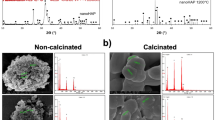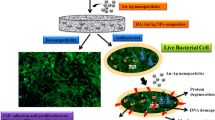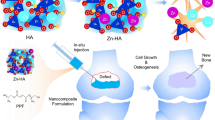Abstract
Purpose
The main purposes of this study were to explore a unique approach for producing nano-hierarchical morphological hydroxyapatite (n-HA) and to evaluate its potential applications in the field of biomedicine, specifically in orthopedics and orthodontics. The research question was whether using glucose 6-phosphate biomolecules as an organic phosphorus source through the pulsed ultrasonic process could generate n-HA nanoparticles with exceptional morphology.
Methods
The researchers employed the pulsed ultrasonochemical process to produce n-HA nanoparticles. The morphologies of the nanoparticles were examined using SEM and TEM techniques. The phase, structure, and composition of the nanoparticles were analyzed through DLS, XRD, XPS, and FTIR spectroscopic techniques. Biological evaluation experiments were conducted to assess the survivability and adhesion of the n-HA nanoparticles to osteoblast cells.
Results
The study found that the morphologies of the n-HA nanoparticles generated varied significantly with alterations in the pulsed ultrasonic settings. SEM and TEM analyses provided visual evidence of the unique nano-hierarchical morphology of the nanoparticles. DLS, Zeta potential, XRD, XPS, and FTIR spectroscopy techniques confirmed the phase, structure, and composition of the n-HA nanoparticles. The biological evaluation experiments indicated that the nanoparticles exhibited favorable survivability and adhesion to osteoblast cells.
Conclusions
This study successfully developed a method for producing nano-hierarchical morphological hydroxyapatite using glucose 6-phosphate biomolecules as an organic phosphorus source through the pulsed ultrasonochemical process. The n-HA nanoparticles generated displayed exceptional morphology and exhibited favorable survivability and adhesion to osteoblast cells. Therefore, these nanoparticles hold promise for potential applications in biomedical fields, particularly in orthopedics and orthodontics.










Similar content being viewed by others
References
Akram M, Ahmed R, Shakir I, Ibrahim WAW, Hussain R. Extracting hydroxyapatite and its precursors from natural resources. J Mater Sci. 2014;49:1461–75.
Jegatheeswaran S, Selvam S, Ramkumar VS, Sundrarajan M. Novel strategy for f-HAp/PVP/Ag nanocomposite synthesis from fluoro based ionic liquid assistance: systematic investigations on its antibacterial and cytotoxicity behaviors. Mater Sci Eng C. 2016;67:8–19.
John Ł, Janeta M, Szafert S. Designing of macroporous magnetic bioscaffold based on functionalized methacrylate network covered by hydroxyapatites and doped with nano-MgFe2O4 for potential cancer hyperthermia therapy. Mater Sci Eng C. 2017;78:901–11.
Pu'ad NM, Koshy P, Abdullah H, Idris M, Lee T. Syntheses of hydroxyapatite from natural sources. Heliyon. 2019;5(5):e01588.
Govindaraj D, Pradeepkumar P, Rajan M. Synthesis of morphology tuning multi mineral substituted apatite nanocrystals by novel natural deep eutectic solvents. Mater Discov. 2017;9:11–5.
Yoruç ABH, Aydınoğlu A. The precursors effects on biomimetic hydroxyapatite ceramic powders. Mater Sci Eng C. 2017;75:934–46.
Zhao XY, Zhu YJ, Qi C, Chen F, Lu BQ, Zhao J, Wu J. Hierarchical hollow hydroxyapatite microspheres: microwave-assisted rapid synthesis by using pyridoxal-5′-phosphate as a phosphorus source and application in drug delivery. Chem–Asian J. 2013;8(6):1313–20.
Jeong H-S, Venkatesan J, Kim S-K. Hydroxyapatite-fucoidan nanocomposites for bone tissue engineering. Int J Biol Macromol. 2013;57:138–41.
Zhao X-Y, Zhu Y-J, Chen F, Lu B-Q, Qi C, Zhao J, Wu J. Hydrothermal synthesis of hydroxyapatite nanorods and nanowires using riboflavin-5′-phosphate monosodium salt as a new phosphorus source and their application in protein adsorption. CrystEngComm. 2013;15(39):7926–35.
Kumar GS, Girija EK, Venkatesh M, Karunakaran G, Kolesnikov E, Kuznetsov D. One step method to synthesize flower-like hydroxyapatite architecture using mussel shell bio-waste as a calcium source. Ceram Int. 2017;43(3):3457–61.
Zhao J, Zhu Y-J, Cheng G-F, Ruan Y-J, Sun T-W, Chen F, Wu J, Zhao X-Y, Ding G-J. Microwave-assisted hydrothermal rapid synthesis of amorphous calcium phosphate nanoparticles and hydroxyapatite microspheres using cytidine 5′-triphosphate disodium salt as a phosphate source. Mater Lett. 2014;124:208–11.
Zhu Y-J, Chen F. Microwave-assisted preparation of inorganic nanostructures in liquid phase. Chem Rev. 2014;114(12):6462–555.
Pol VG, Li Y, Dogan F, Secor E, Thackeray MM, Abraham DP. Pulsed sonication for alumina coatings on high-capacity oxides: performance in lithium-ion cells. J Power Sources. 2014;258:46–53.
Taguchi M, Schwalb N, Rong Y, Vanegas D, Garland N, Tan M, Yamaguchi H, Claussen J, McLamore E. Pulsed: pulsed sonoelectrodeposition of fractal nanoplatinum for enhancing amperometric biosensor performance. Analyst. 2016;141(11):3367–78.
Rousse C, Josse J, Mancier V, Levi S, Gangloff SC, Fricoteaux P. Synthesis of copper–silver bimetallic nanopowders for a biomedical approach; study of their antibacterial properties. RSC Adv. 2016;6(56):50933–40.
Soltani RDC, Safari M. Periodate-assisted pulsed sonocatalysis of real textile wastewater in the presence of MgO nanoparticles: response surface methodological optimization. Ultrason Sonochem. 2016;32:181–90.
Burrs S, Bhargava M, Sidhu R, Kiernan-Lewis J, Gomes C, Claussen J, McLamore E. A paper based graphene-nanocauliflower hybrid composite for point of care biosensing. Biosens Bioelectron. 2016;85:479–87.
Tian W-N, Braunstein LD, Pang J, Stuhlmeier KM, Xi Q-C, Tian X, Stanton RC. Importance of glucose-6-phosphate dehydrogenase activity for cell growth. J Biol Chem. 1998;273(17):10609–17.
Yu Y-D, Zhu Y-J, Qi C, Wu J. Solvothermal synthesis of hydroxyapatite with various morphologies using trimethyl phosphate as organic phosphorus source. Mater Lett. 2017;193:165–8.
Filova E, Fojt J, Kryslova M, Moravec H, Joska L, Bacakova L. The diameter of nanotubes formed on Ti-6Al-4V alloy controls the adhesion and differentiation of Saos-2 cells. Int J Nanomedicine. 2015;10:7145.
Assis CM, Vercik LC, Santos ML, Fook MV, Guastaldi AC. Comparison of crystallinity between natural hydroxyapatite and synthetic cp-Ti/HA coatings. Mater Res. 2005;8:207–11.
Fowler B, Moreno E, Brown W. Infra-red spectra of hydroxyapatite, octacalcium phosphate and pyrolysed octacalcium phosphate. Arch Oral Biol. 1966;11(5):477–92.
Qi C, Zhu Y-J, Wu C-T, Sun T-W, Jiang Y-Y, Zhang Y-G, Wu J, Chen F. Sonochemical synthesis of hydroxyapatite nanoflowers using creatine phosphate disodium salt as an organic phosphorus source and their application in protein adsorption. RSC Adv. 2016;6(12):9686–92.
Qi C, Zhu YJ, Chen F. Fructose 1, 6-Bisphosphate Trisodium Salt as A New Phosphorus Source for the Rapid Microwave Synthesis of Porous Calcium–Phosphate Microspheres and their Application in Drug Delivery. Chem–Asian J. 2013;8(1):88–94.
Govindaraj D, Rajan M, Munusamy MA, Higuchi A. Mineral substituted hydroxyapatite coatings deposited on nanoporous TiO 2 modulate the directional growth and activity of osteoblastic cells. RSC Adv. 2015;5(73):58980–8.
Tas AC. Granules of brushite and octacalcium phosphate from marble. J Am Ceram Soc. 2011;94(11):3722–6.
Suzuki O, Kamakura S, Katagiri T, Nakamura M, Zhao B, Honda Y, Kamijo R. Bone formation enhanced by implanted octacalcium phosphate involving conversion into Ca-deficient hydroxyapatite. Biomaterials. 2006;27(13):2671–81.
Kłosowski MM, Friederichs RJ, Nichol R, Antolin N, Carzaniga R, Windl W, Best SM, Shefelbine SJ, McComb DW, Porter AE. Probing carbonate in bone forming minerals on the nanometre scale. Acta Biomater. 2015;20:129–39.
Milella E, Cosentino F, Licciulli A, Massaro C. Preparation and characterisation of titania/hydroxyapatite composite coatings obtained by sol–gel process. Biomaterials. 2001;22(11):1425–31.
Zhang C-Y, Zhang W, Mao L-B, Zhao Y, Yu S-H. Biomimetic mineralization of zein/calcium phosphate nanocomposite nanofibrous mats for bone tissue scaffolds. CrystEngComm. 2014;16(40):9513–9.
Suzuki O. Octacalcium phosphate (OCP)-based bone substitute materials. Jpn Dent Sci Rev. 2013;49(2):58–71.
Ma M-G. Hierarchically nanostructured hydroxyapatite: hydrothermal synthesis, morphology control, growth mechanism, and biological activity. Int J Nanomed. 2012;7:1781–91.
Govindaraj D, Rajan M, Munusamy MA, Balakumaran MD, Kalaichelvan PT. Osteoblast compatibility of minerals substituted hydroxyapatite reinforced poly (sorbitol sebacate adipate) nanocomposites for bone tissue application. RSC Adv. 2015;5(55):44705–13.
Arellano-Jiménez M, García-García R, Reyes-Gasga J. Synthesis and hydrolysis of octacalcium phosphate and its characterization by electron microscopy and X-ray diffraction. J Phys Chem Solids. 2009;70(2):390–5.
Govindaraj D, Rajan M, Munusamy MA, Alarfaj AA, Kumar SS. Mineral-substituted hydroxyapatite reinforced poly (raffinose-citric acid)–polyethylene glycol nanocomposite enhances osteogenic differentiation and induces ectopic bone formation. New J Chem. 2017;41(8):3036–47.
Al-Juboori RA, Yusaf T, Aravinthan V, Bowtell L. Investigating natural organic carbon removal and structural alteration induced by pulsed ultrasound. Sci Total Environ. 2016;541:1019–30.
Karthi S, Kumar G, Sardar D, Dannangoda G, Martirosyan K, Girija E. Fluorapatite coated iron oxide nanostructure for biomedical applications. Mater Chem Phys. 2017;193:356–63.
Lahiri D, Benaduce AP, Kos L, Agarwal A. Quantification of carbon nanotube induced adhesion of osteoblast on hydroxyapatite using nano-scratch technique. Nanotechnology. 2011;22(35):355703.
Author information
Authors and Affiliations
Corresponding author
Ethics declarations
Conflict of Interest
The authors of this study did not report any conflicts of interest to disclose.
Additional information
Publisher’s Note
Springer Nature remains neutral with regard to jurisdictional claims in published maps and institutional affiliations.
Rights and permissions
Springer Nature or its licensor (e.g. a society or other partner) holds exclusive rights to this article under a publishing agreement with the author(s) or other rightsholder(s); author self-archiving of the accepted manuscript version of this article is solely governed by the terms of such publishing agreement and applicable law.
About this article
Cite this article
Han, L., Wang, D. Osteocompatible Zinc-Copper Substituted Hydroxyapatite Reinforced Biocomposites for Bone Tissue Regeneration. J Pharm Innov 19, 26 (2024). https://doi.org/10.1007/s12247-024-09833-x
Accepted:
Published:
DOI: https://doi.org/10.1007/s12247-024-09833-x




